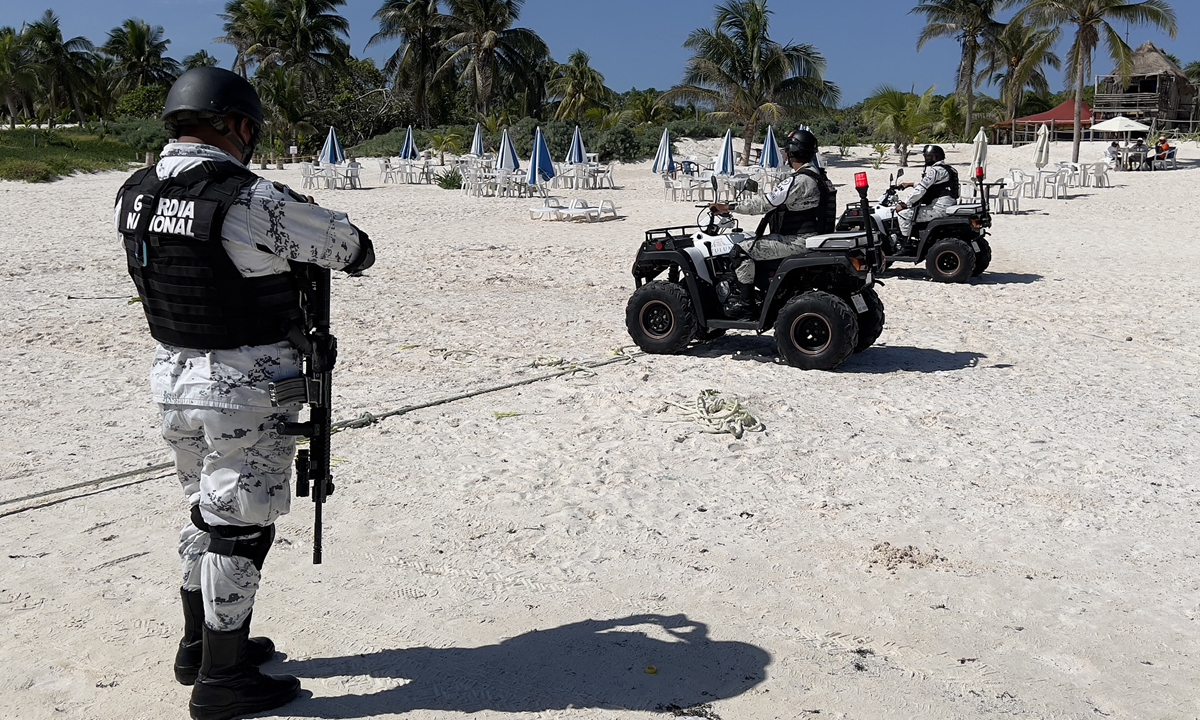
Mexican police officers patrol the Tulum beach on October 30. Photo: AFP
Mexican soldiers patrol the beach of Tulum while investigators reconstruct a crime scene in the once-sleepy Caribbean resort, reeling from the deaths of two tourists caught in gang crossfire.
"Are they filming a movie?" asks Lukas Smith, a Canadian tourist visiting the town known for its ancient Mayan ruins, turquoise waters and - more recently - dance music parties.
But the troops and forensic experts working at a restaurant in downtown Tulum are not actors.
It was here that a shootout between rival drug dealers last month claimed the lives of German tourist Jennifer Henzold, 35, and Indian travel blogger Anjali Ryot, 25.
Two more German visitors and one from the Netherlands were injured.
On November 4, another gang shooting sent tourists in swimsuits fleeing in panic from a beach near Cancun further north on the Riviera Maya. Two suspected drug dealers were killed.
The violence has shone a spotlight on the dark side of Tulum and other Mexican resorts hit by turf wars between gangs involved in drug dealing and extortion.
The army and National Guard have since stepped up patrols on the streets and beaches of Tulum, where troops with rifles and bulletproof vests are now seen riding quad bikes.
Hoteliers worriedThe town of 46,000 inhabitants receives about 4 million visitors a year following in the footsteps of celebrities such as Leonardo DiCaprio and Demi Moore.
But the violence is taking its toll, says David Ortiz, president of the Tulum Hotel Association. "It has a lot to do with drug dealing" linked to electronic dance music parties, he says.
While many of the world's major tourist destinations closed to foreigners during the pandemic, Mexico remained open.
Tulum became a magnet for people who wanted to dance all night next to lush jungle, freshwater sinkholes and golden beaches. The huge parties have spawned a lucrative market for drug dealers, Ortiz says.
The hotel association is unhappy about nightlife events that have tarnished Tulum's once bohemian-chic image.
Following the double homicide, bookings for the next season have dropped by about a fifth, Ortiz says.
Germany issued a travel warning for Tulum and other Riviera Maya resorts such as Playa del Carmen, where three foreigners were among five killed in a shooting at an electronic music festival in 2017.
'Memorable experiences'Some tourists, however, feel it is worth the risk.
Spanish tourist Luisa Fernanda Jimenez, 24, says she feels safe in Mexico although certain precautions were necessary.
Her friend Natalia Lopez, 27, heard about the shooting from the media but says she will not let it spoil her visit.
"I came to Tulum for positive vibrations. I don't want to know anything!" she says.
Oscar Montes de Oca, attorney general of the state of Quintana Roo, which is home to Tulum, blames the violence on gangs dealing drugs and demanding protection money from businesses.
Even so, Tulum remains a safe place, says local tourism chief Eugenio Barbacha. Visitors "for the most part have memorable experiences," he says.
Tourism represents 8.5 percent of Mexico's gross domestic product and is the main economic activity in the southeast region, which includes the Riviera Maya.
Other major Mexican destinations such as the Pacific coastal city of Acapulco have faced serious security problems for years.
In recent weeks, a tourist, a journalist and a bus driver have been shot dead there, according to authorities, who report frequent shootings.
In an incident caught on video, unidentified arsonists in September set fire to the iconic Baby'O Acapulco nightclub that in its heyday hosted stars such as Rod Stewart, Bono and Elizabeth Taylor.




